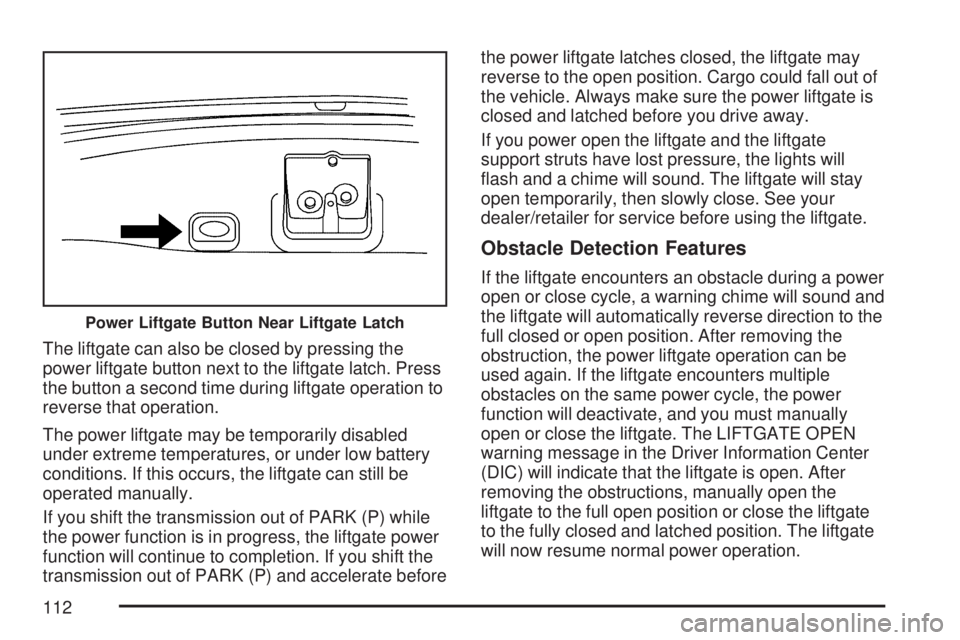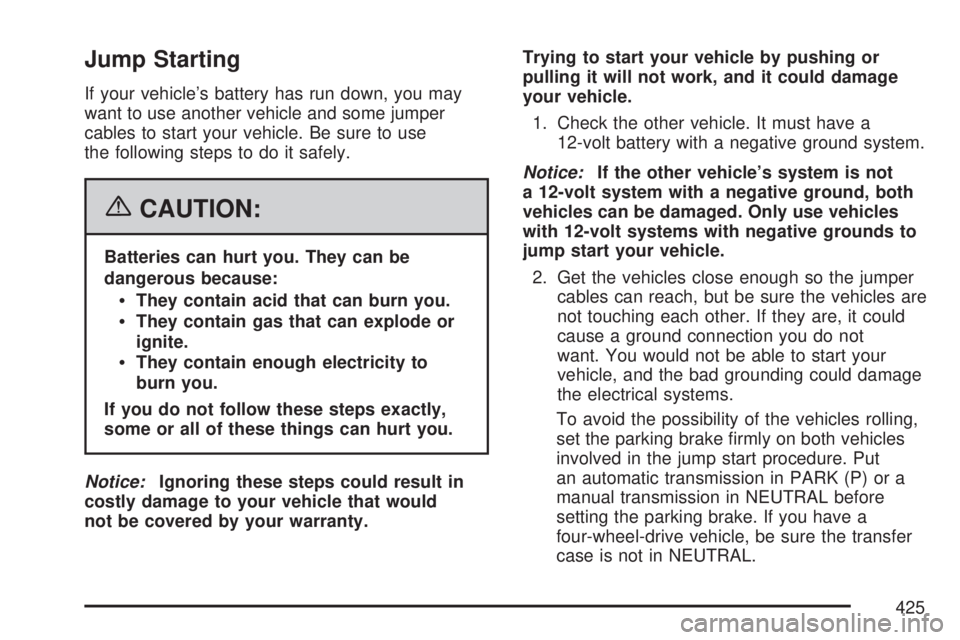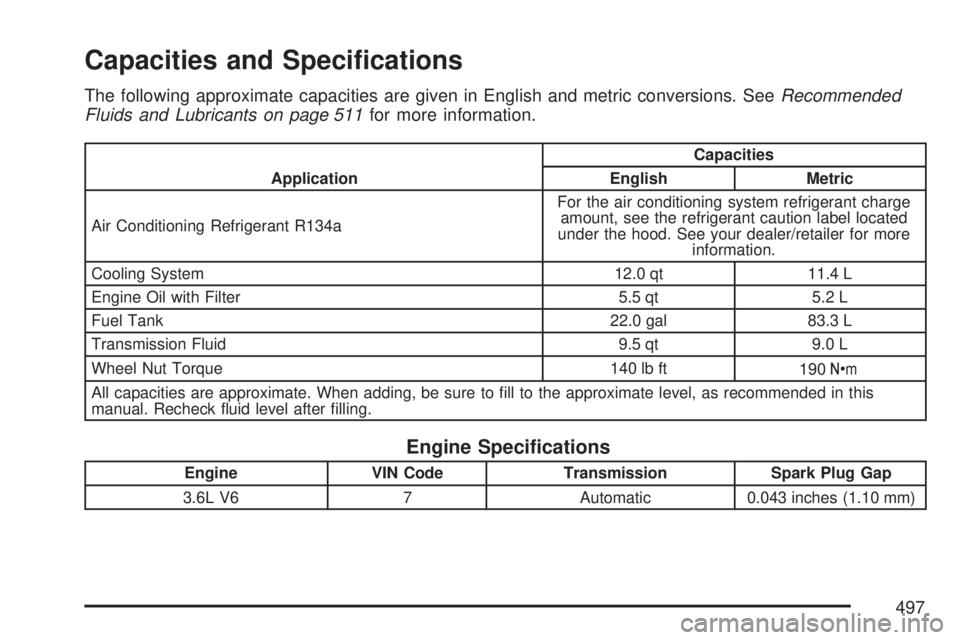2007 GMC ACADIA manual transmission
[x] Cancel search: manual transmissionPage 112 of 554

The liftgate can also be closed by pressing the
power liftgate button next to the liftgate latch. Press
the button a second time during liftgate operation to
reverse that operation.
The power liftgate may be temporarily disabled
under extreme temperatures, or under low battery
conditions. If this occurs, the liftgate can still be
operated manually.
If you shift the transmission out of PARK (P) while
the power function is in progress, the liftgate power
function will continue to completion. If you shift the
transmission out of PARK (P) and accelerate beforethe power liftgate latches closed, the liftgate may
reverse to the open position. Cargo could fall out of
the vehicle. Always make sure the power liftgate is
closed and latched before you drive away.
If you power open the liftgate and the liftgate
support struts have lost pressure, the lights will
�ash and a chime will sound. The liftgate will stay
open temporarily, then slowly close. See your
dealer/retailer for service before using the liftgate.
Obstacle Detection Features
If the liftgate encounters an obstacle during a power
open or close cycle, a warning chime will sound and
the liftgate will automatically reverse direction to the
full closed or open position. After removing the
obstruction, the power liftgate operation can be
used again. If the liftgate encounters multiple
obstacles on the same power cycle, the power
function will deactivate, and you must manually
open or close the liftgate. The LIFTGATE OPEN
warning message in the Driver Information Center
(DIC) will indicate that the liftgate is open. After
removing the obstructions, manually open the
liftgate to the full open position or close the liftgate
to the fully closed and latched position. The liftgate
will now resume normal power operation.
Power Liftgate Button Near Liftgate Latch
112
Page 381 of 554

3. When the chocks are in place, release the
regular brakes until the chocks absorb
the load.
4. Reapply the regular brakes. Then apply your
parking brake and shift into PARK (P).
5. Release the regular brakes.
When You Are Ready to Leave After
Parking on a Hill
1. Apply your regular brakes and hold the pedal
down while you:
start your engine,
shift into a gear, and
release the parking brake.
2. Let up on the brake pedal.
3. Drive slowly until the trailer is clear of the
chocks.
4. Stop and have someone pick up and store
the chocks.
Maintenance When Trailer Towing
Your vehicle will need service more often
when you’re pulling a trailer. SeeScheduled
Maintenance on page 502for more information.
Things that are especially important in trailer
operation are automatic transmission �uid
(don’t over�ll), engine oil, axle lubricant, drive
belt, cooling system and brake system. Each of
these is covered in this manual, and the Index will
help you �nd them quickly. If you’re trailering,
it’s a good idea to review this information before
you start your trip.
Check periodically to see that all hitch nuts and
bolts are tight.
381
Page 425 of 554

Jump Starting
If your vehicle’s battery has run down, you may
want to use another vehicle and some jumper
cables to start your vehicle. Be sure to use
the following steps to do it safely.
{CAUTION:
Batteries can hurt you. They can be
dangerous because:
They contain acid that can burn you.
They contain gas that can explode or
ignite.
They contain enough electricity to
burn you.
If you do not follow these steps exactly,
some or all of these things can hurt you.
Notice:Ignoring these steps could result in
costly damage to your vehicle that would
not be covered by your warranty.Trying to start your vehicle by pushing or
pulling it will not work, and it could damage
your vehicle.
1. Check the other vehicle. It must have a
12-volt battery with a negative ground system.
Notice:If the other vehicle’s system is not
a 12-volt system with a negative ground, both
vehicles can be damaged. Only use vehicles
with 12-volt systems with negative grounds to
jump start your vehicle.
2. Get the vehicles close enough so the jumper
cables can reach, but be sure the vehicles are
not touching each other. If they are, it could
cause a ground connection you do not
want. You would not be able to start your
vehicle, and the bad grounding could damage
the electrical systems.
To avoid the possibility of the vehicles rolling,
set the parking brake �rmly on both vehicles
involved in the jump start procedure. Put
an automatic transmission in PARK (P) or a
manual transmission in NEUTRAL before
setting the parking brake. If you have a
four-wheel-drive vehicle, be sure the transfer
case is not in NEUTRAL.
425
Page 497 of 554

Capacities and Speci�cations
The following approximate capacities are given in English and metric conversions. SeeRecommended
Fluids and Lubricants on page 511for more information.
ApplicationCapacities
English Metric
Air Conditioning Refrigerant R134aFor the air conditioning system refrigerant charge
amount, see the refrigerant caution label located
under the hood. See your dealer/retailer for more
information.
Cooling System 12.0 qt 11.4 L
Engine Oil with Filter 5.5 qt 5.2 L
Fuel Tank 22.0 gal 83.3 L
Transmission Fluid 9.5 qt 9.0 L
Wheel Nut Torque 140 lb ft
190Y
All capacities are approximate. When adding, be sure to �ll to the approximate level, as recommended in this
manual. Recheck �uid level after �lling.
Engine Speci�cations
Engine VIN Code Transmission Spark Plug Gap
3.6L V6 7 Automatic 0.043 inches (1.10 mm)
497
Page 535 of 554

Service Publications Ordering
Information
Service Manuals
Service Manuals have the diagnosis and repair
information on engines, transmission, axle
suspension, brakes, electrical, steering, body, etc.
Transmission, Transaxle, Transfer
Case Unit Repair Manual
This manual provides information on unit repair
service procedures, adjustments, and
speci�cations for GM transmissions, transaxles,
and transfer cases.
Service Bulletins
Service Bulletins give technical service information
needed to knowledgeably service General
Motors cars and trucks. Each bulletin contains
instructions to assist in the diagnosis and service
of your vehicle.In Canada, the service bulletin reference number
can be obtained by contacting your General
Motors dealer or by calling 1-800-GM-DRIVE
(1-800-463-7483). This reference number is
needed to order the service bulletin from
Helm, Inc.
RETAIL SELL PRICE: $6.00 US + Processing Fee
Owner Information
Owner publications are written speci�cally for
owners and intended to provide basic operational
information about the vehicle. The owner
manual includes the Maintenance Schedule for
all models.
In-Portfolio: Includes a Portfolio, Owner Manual,
and Warranty Booklet.
RETAIL SELL PRICE: $35.00 US
+ Processing Fee
Without Portfolio: Owner Manual only.
RETAIL SELL PRICE: $25.00 US
+ Processing Fee
535
Page 536 of 554

Current and Past Model Order Forms
Technical Service Bulletins and Manuals are
available for current and past model GM vehicles.
To request an order form, specify year and
model name of the vehicle.
ORDER TOLL FREE: 1-800-551-4123
Monday-Friday 8:00 AM - 6:00 PM
Eastern Time
For Credit Card Orders Only
(VISA-MasterCard-Discover), visit Helm, Inc. on
the World Wide Web at: www.helminc.com
Or you can write to:
Helm, Incorporated
P.O. Box 07130
Detroit, MI 48207
Prices are subject to change without notice and
without incurring obligation. Allow ample time
for delivery.
Note to Canadian Customers: All listed prices are
quoted in U.S. funds. Canadian residents are
to make checks payable in U.S. funds.
Vehicle Data Recording
and Privacy
Your GM vehicle has a number of sophisticated
computers that record information about the
vehicle’s performance and how it is driven.
For example, your vehicle uses computer modules
to monitor and control engine and transmission
performance, to monitor the conditions for
airbag deployment and deploy airbags in a crash
and, if so equipped, to provide anti-lock braking
to help the driver control the vehicle. These
modules may store data to help your dealer/retailer
technician service your vehicle. Some modules
may also store data about how you operate
the vehicle, such as rate of fuel consumption or
average speed. These modules may also
retain the owner’s personal preferences, such as
radio pre-sets, seat positions, and temperature
settings.
536
Page 540 of 554

Audio System.............................................. 264
Audio Steering Wheel Controls................. 325
Care of Your CD and DVD Player............ 328
Care of Your CDs and DVDs................... 328
Navigation/Radio System,
see Navigation Manual......................... 311
Radio with CD......................................... 268
Rear Audio Controller (RAC).................... 324
Rear Seat Audio (RSA)............................ 322
Setting the Time...................................... 266
Theft-Deterrent Feature............................ 325
Understanding Radio Reception............... 326
Audio System(s)
Radio with CD and DVD.......................... 278
Automatic Transmission
Fluid........................................................ 404
Operation................................................. 129B
Battery........................................................ 424
Electric Power Management..................... 188
Run-Down Protection............................... 189
Before Leaving on a Long Trip.................... 352
Brake
Emergencies............................................ 336
Parking.................................................... 134
Brakes........................................................ 421
System Warning Light.............................. 222
Braking....................................................... 334
Braking in Emergencies............................... 336
Break-In, New Vehicle................................. 123
Bulb Replacement....................................... 432
Halogen Bulbs......................................... 432
Headlamp Aiming..................................... 431
High Intensity Discharge (HID) Lighting.... 432
License Plate Lamps................................ 433
Replacement Bulbs.................................. 433
Buying New Tires........................................ 450
540